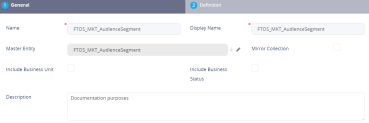Configuration Data Definitions
This menu item aids users of FintechOS Studio with exporting data such as an entity's values/ records from a certain environment. Thus, the data is readily made available to employees who work on different environments and who need information quickly and securely.
By building a data definition here and later on a package, you are able to export data locally from the FintechOS Studio.
For example to export an entity and its records follow the steps:
- In Exporting a Deployment Package, create a package with the entity and its unique constraint.
- In Configuration Data Definitions, create a definition for the records of the entity.
- Return to the Deployment package and add as item next to the entity the definition.
- From the Deployment package, export the basic package.
- From the Configuration Data Deployment Package, export the records.
When you wish to import the package on the same database, you must change the name of the package. If the database is different you can keep the name.
To achieve creating the data definition from step 2, follow the course of actions listed below:
- Open FintechOS Studio and select DevOps > Configuration Data Definitions. The Configuration Data Definitions List opens.
- Click the Insert button at the top-right of the screen. The General configuration page opens.
- Fill in the following fields:
Field Required
Data type Description Name Yes
Text Name of the package. Display Name Yes Text Name shown in the Portal. Master entity No
Option set The entity on which the export is built. Mirror collection No
Bool This option enables the process of replacing the same records with the same name and values. It updates the data.
For example, for a N-to-N relationship, if the bool is not ticked, and in the source entity there is an attribute cash and in the target entity there is an attribute card, after import the target entity will have both cash and card.
If the bool is ticked, the cash attribute will stay and the system will delete the card reference.
DataConfigDefinition No
Lookup Once it is saved, it cannot be edited. Include business unit No Bool This includes the security elements set for the data. Include business status
No
Bool
When a business workflow is attached to the entity, the status will be exported in the file. Each row has a status. For example the statuses can be:
- Previous Status
- Current status
- Next Status (for a predefined workflow).
Description
No
Text area
Insert the details here.
- Click the Save and reload button and click on the Definition tab to select the data.
- Click the Edit button at the right side of each attribute, and fill in the following information:
Field Required
Data type Description Name Yes Text This is the name of the attribute. Type No Text This is the type of attribute. Entity name No Text This is the entity selected before in step 1. Include No Bool This bool ticks if you wish to include the attribute in the export. Internal name No Text It is made up of the Name + "v"+Version + exportDate. Update only reference No Bool This field is mandatory ticked, for parent-child relationship between entities. Identification constraint name No Option set Select the constraint created earlier. For more information, see Entity Unique Constraints. NOTE If the entity A has a lookup attribute to another entity B or entity A is a child to entity B that in turn is parent to A, those attributes will be shown in the file, but if they are not included, the records will be empty i.e. will reference as none. - Click Save to add the attribute or click Cancel to cancel the process.
Repeat for as many attributes as needed.
To export the package follow the steps from the Configuration Data Deployment Package page.



